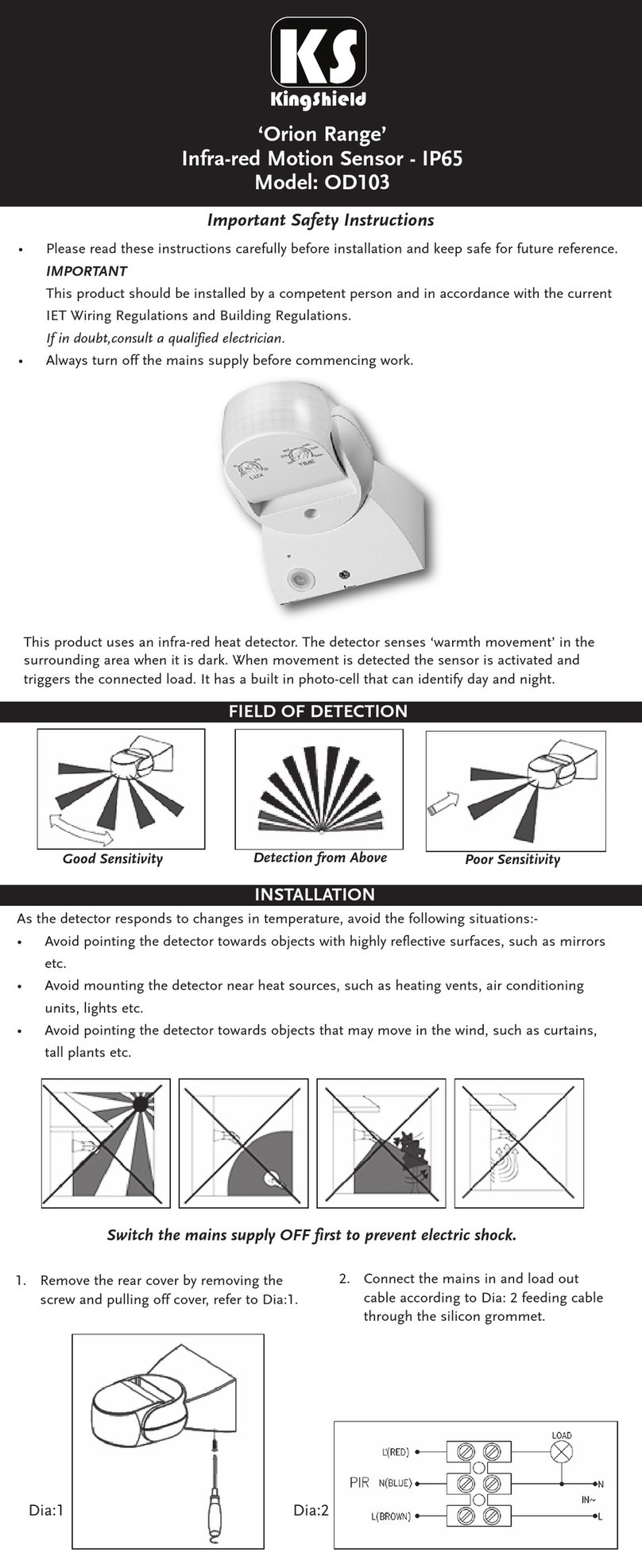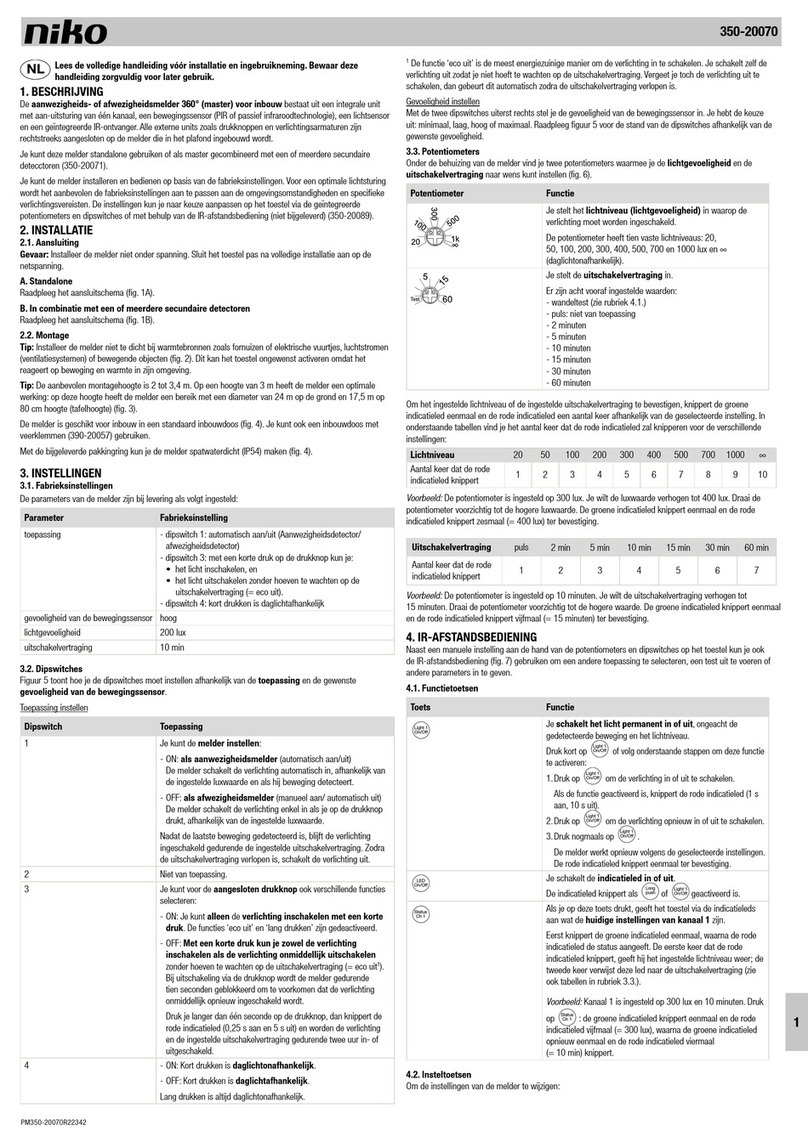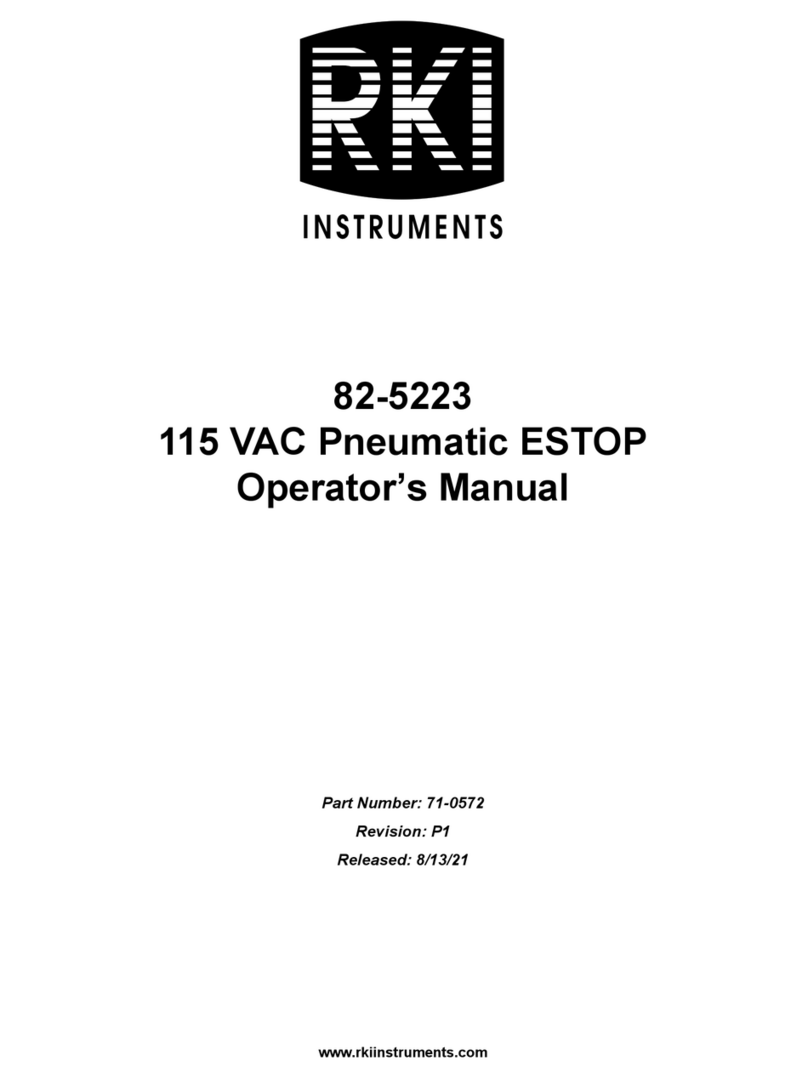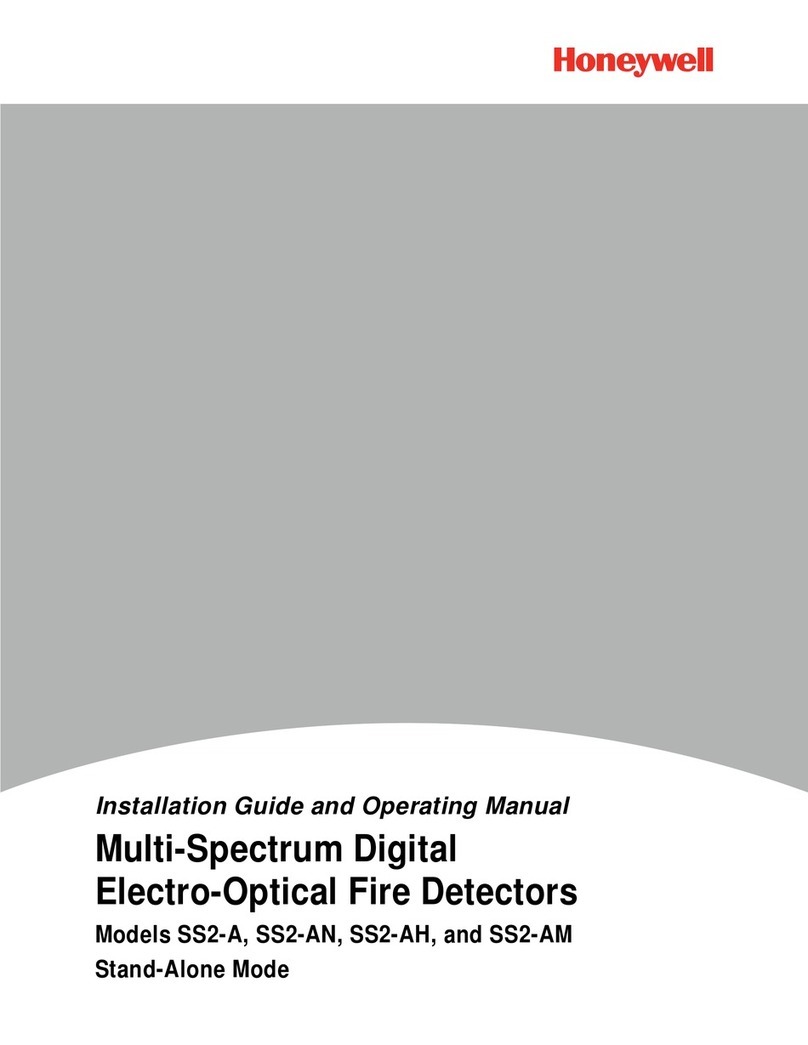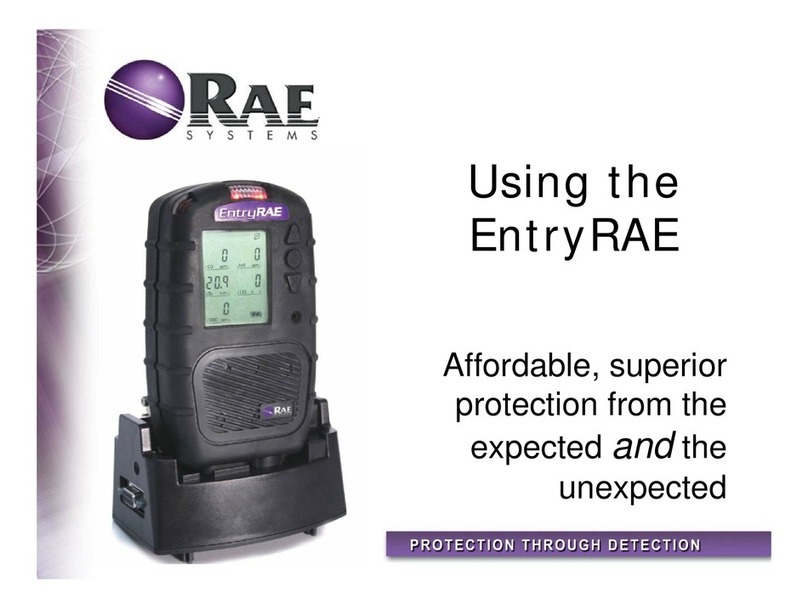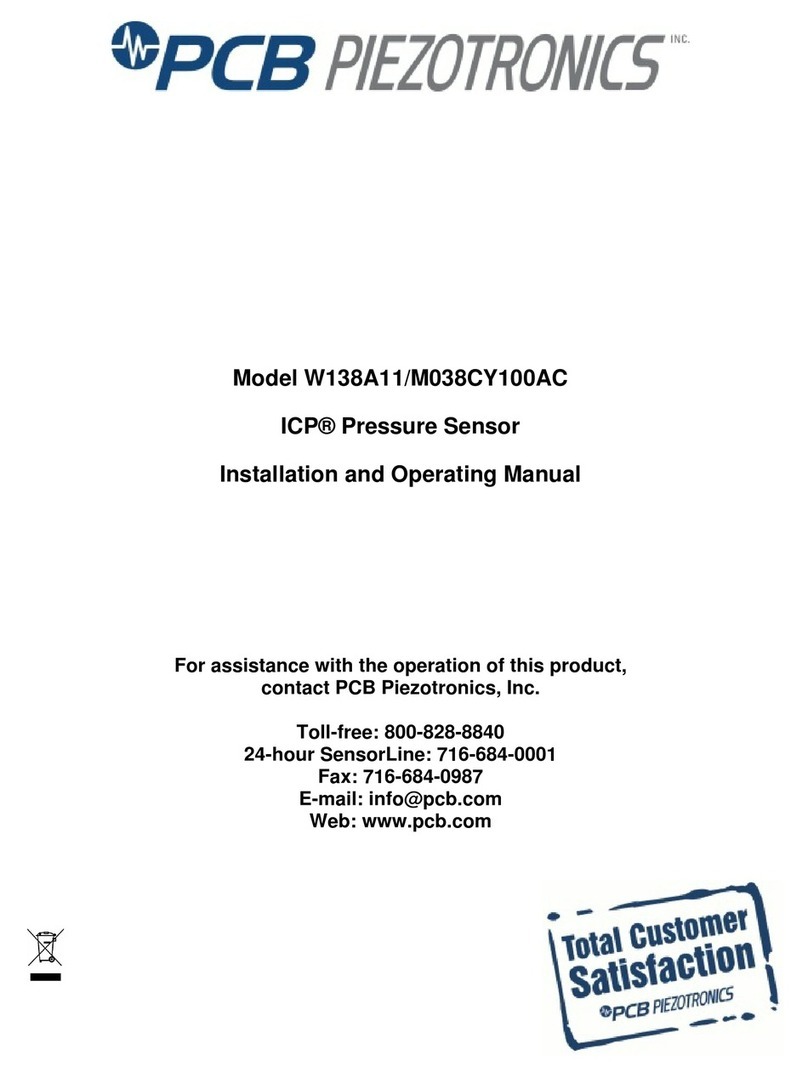Thorne & Derrick ToxiRAE 3 User manual

ToxiRAE 3
User’s Guide
P/N G01-4002-000 Rev. C
May 2008

© Copyright 2008 RAE Systems, Inc.

ToxiRAE 3 User’s Guide
Page 1
Contents
1. General Information............................................................................................................................ 6
2. Specifications...................................................................................................................................... 7
3. Overview............................................................................................................................................. 8
4. User Interface...................................................................................................................................... 8
5. Turning The ToxiRAE 3 On ............................................................................................................... 8
6. Turning The ToxiRAE 3 Off .............................................................................................................. 9
7. Testing The Alarms (Anytime) ........................................................................................................... 9
8. Low Battery Warnings...................................................................................................................... 10
9. Dead Battery Warning & Shutoff ..................................................................................................... 10
10. Operating The ToxiRAE 3.............................................................................................................. 11
10.1. Mode Overview............................................................................................................... 11
10.2. Normal Mode .................................................................................................................. 12
10.2.1. Enter Normal Mode / Turn On The ToxiRAE 3.............................................................. 12
10.2.2. Display And Disposable Sub-Modes ...............................................................................12
10.2.3. Exit Normal Mode / Turn Off The ToxiRAE 3 ............................................................... 13
10.2.4. Stepping Through Normal Mode ..................................................................................... 14
10.2.5. Clearing STEL, TWA, And Peak Values.........................................................................15
10.2.6. Programming Mode ......................................................................................................... 16
10.2.7. Enter Programming Mode................................................................................................ 16
10.2.8. Navigating Programming Mode....................................................................................... 18
11. Bump Testing & Calibrating The ToxiRAE 3 ................................................................................ 19
11.1. Bump Testing And Calibration With An AutoRAE Lite................................................ 20
11.2. Calibration Adapter......................................................................................................... 20
11.2.1. Connecting The Calibration Adapter ............................................................................... 20
11.2.2. Disconnecting The Calibration Adapter...........................................................................21
11.2.3. Calibrations And Settings In Programming Mode........................................................... 21
11.2.4. Zero (Fresh Air) Calibration ............................................................................................ 21
11.2.5. Span Calibration............................................................................................................... 22
11.2.6. Set Span Gas Value.......................................................................................................... 23
11.2.7. Set High Alarm Value......................................................................................................23
11.2.8. Set Low Alarm Value ...................................................................................................... 24
11.2.9. Set STEL Alarm Value ....................................................................................................24
11.2.10. Set TWA Alarm Value................................................................................................... 25
11.2.11. Set Bump Due Day ........................................................................................................25
11.2.12. Set Calibration Due Day ................................................................................................ 26
11.2.13. End Programming (Exit To Normal Mode)...................................................................26
11.3. Bump Testing.................................................................................................................. 26
12. Diagnostic Mode............................................................................................................................. 27
12.1. Enter Diagnostic Mode ................................................................................................... 27
12.2. Navigating Diagnostic Mode .......................................................................................... 27
12.3. Exit Diagnostic Mode ..................................................................................................... 27
13. Alarm Signal Summary................................................................................................................... 28
14. Maintenance.................................................................................................................................... 30
14.1. Replacing the ToxiRAE 3 Li-Ion Battery ....................................................................... 30
14.1.1. Cleaning........................................................................................................................... 31
14.1.2. Ordering Replacement Parts ............................................................................................31
15. Troubleshooting .............................................................................................................................. 32
16. Technical Support ........................................................................................................................... 33
17. RAE Systems Contacts ................................................................................................................... 33
18. Appendix A: Regulatory Information ............................................................................................. 36
18.1. Maintenance.................................................................................................................... 37
18.1.1. Replacing the Lithium Battery.........................................................................................38

ToxiRAE 3 User’s Guide
WARNINGS
Read Before Operating
This manual must be carefully read by all individuals who have or will have the
responsibility of using, maintaining, or servicing this product. The product will perform
as designed only if it is used, maintained, and serviced in accordance with the
manufacturer’s instructions.
CAUTION!
Never operate the monitor when the cover is removed. Remove the monitor cover and
battery only in an area known to be non-hazardous.
Warranty Registration
Register your warranty online by visiting:
http://www.raesystems.com/Support/ProductRegistration
This ensures that your ToxiRAE 3 is registered and ensures that we can let you know of
important updates.
Page 2

ToxiRAE 3 User’s Guide
WARNINGS
Use only RAE Systems lithium battery part number 500-0076-100 (3.6V, 1650mAH, size
2/3AA). This instrument has not been tested in an explosive gas/air atmosphere having an
oxygen concentration greater than 21%. Substitution of components may impair
suitability for intrinsic safety. Replace batteries only in non-hazardous locations.
STATIC HAZARD: Clean only with a damp cloth.
For safety reasons this equipment must be operated and serviced by qualified personnel
only. Read and understand instruction manual completely before operating or servicing.
All newly purchased RAE Systems instruments should be bump tested by exposing the
sensor(s) to known concentrations of calibration gas.
The monitor should be calibrated if it does not pass a bump test, but no less than every 6
months, depending on use and exposure to gas and contamination, and its operational
mode.
Bump test is defined as an exposure to gas that triggers the lowest alarm.
• Calibration intervals and bump test procedures may vary due to national legislation.
• RAE Systems recommends using RAE calibration gas cylinders with 10 ppm H2S (25
ppm H2S can be used as well), 50 ppm CO (100 ppm CO can be used as well), or a 4-
gas mix containing 10 ppm H2S, 50 ppm CO, 50% LEL Methane, and 18.5% Oxygen.
ToxiRAE 3 is certified for use in hazardous locations listed below.
Intrinsic Safety:
US & Canada: Class I, Division 1, Groups A, B, C, D, T4
CE 0575 II 1G Ex ia IIc T4 DNV 2007 OSL-ATEX-9012x
Ex ia IIC T4 IECEx DNV 07. 0004x
-20° C≤Tamb≤+60° C
Page 3

ToxiRAE 3 User’s Guide
Intended operation area and conditions
Hazardous Area classified by Zones
ToxiRAE 3 is intended to be used in hazardous areas susceptible to firedamp and
classified zone 0, 1 or 2 in the temperature range of -20o C to +60o C, where gases of
explosion groups IIa, IIB or IIC, T4 may be present.
Hazardous Area classified by Divisons
ToxiRAE 3 is intended to be used in hazardous areas, classified Class I, Division 1 or 2,
in the temperature range of -20oC to +60oC, where gases of groups A, B, C or D may be
present.
.
Page 4

ToxiRAE 3 User’s Guide
AVERTISSEMENT
Utiliser seulement la batterie Lithium RAE Systems référence 500-0076-100 (3.6V,
1650mAH, format 2/3AA). Cet instrument n’a pas été testé dans une atmosphère de
gaz/air explosive ayant une concentration d’oxygène plus élevée que 21%. La
substitution de composants peut compromettre la sécurité intrinsèque. Ne changer les
batteries que dans un emplacement désigné non dangereux.
RISQUE D'ORIGINE ELECTROSTATIQUE: Nettoyer uniquement avec un chiffon
humide.
Pour des raisons de sécurité, cet équipement doit être utilisé et entretenu uniquement par
un personnel qualifié. Étudier le manuel d’instructions en entier avant d’utiliser, ou
d’entretenir l’équipement.
Tout appareil neuf de RAE Systems doit préalablement passer le test de vérification
d’étalonnage qui consiste à exposer le ou les capteurs a une concentration connue de gaz
étalon.
Le détecteur doit être impérativement étalonné s’il ne passe pas le test de vérification
d’étalonnage, ou bien au moins tous les 6 mois, selon l’utilisation et l’exposition a des
gaz poisons ou des contaminants, et selon le mode opératoire.
Une vérification d’étalonnage est définie par une exposition du détecteur au gaz
d’étalonnage qui doit déclencher le seuil d’alarmes bas.
Page 5

ToxiRAE 3 User’s Guide
1. General Information
ToxiRAE 3 is a programmable single-gas monitor designed to provide exposure
monitoring for workers in hazardous environments.
Key Features
Lightweight and Compact
3.5 oz (99 g), handheld size.
Dependable and Accurate
User Friendly
Menu-driven, intuitive end-use operation.
Programmable Alarm Thresholds
Audio buzzer and flashing display alarm.
•Standard configuration includes CO (low), CO (high), or H2S sensor
•Replaceable Li-ion battery
•Large, easy-to-read display
•Event logging
•Visual alarm with bright red flashing LEDs
•Loud audible alarm (95dB at 30 cm)
•Vibration alarm
•Rugged weather-resistant case
Page 6

ToxiRAE 3 User’s Guide
2. Specifications
ToxiRAE 3 Specifications
Configuration Diffusion single-gas with event logging for up to 10
events
Dimensions 3.4" L x 2.2" W x 0.8" H (8.6 cm x 5.5 cm x 2.0 cm)
Weight 3.5 oz (99 g) with battery
Battery User-replaceable 2/3 AA high-capacity lithium
Alarms •95 dB (at 30 cm) buzzer and flashing red LED to
indicate exceeded preset limits
•High: Displays “High” and emits 3 beeps and
flashes per second
•Low: Displays “Low” and emits 2 beeps and flashes
per second
•STEL: Displays “STEL” and emits 1 beep and flash
per second
•TWA: Displays “TWA” and emits 1 beep and flash
per second
•Vibration alarm
•6-LED visible alarm
Operating Time 2 years, without IR communication usage
Display LCD
Keypad 2 programming/operation keys
Direct Readout Measured gas value with sensor name, battery charge,
high and low value, elapsed time, and event logging
on/off state
Sampling Method Diffusion
Range &
Resolution Sensor Range (ppm) Resolution (ppm)
H2S 0 to 100 0.1
CO 0 to 500 1
CO 0 to 1999 1
Datalogging 10 events
Response Time T90 < 12 seconds
Calibration Two-point calibration for zero and span
IP Rating IP-67
Protection: Password protected calibration settings, alarm limits,
and data
Certification: US and Canada: C1D1, Groups A, B, C, D, T4
Europe: ATEX II 1G EEx ia IIC T4
IECEX: Ex ia IIC T4
Operating
Temperature Continuous: -20° C to +60° C
Humidity 0 to 95% relative humidity (non-condensing)
Warranty 2 years, including sensor and battery if used within
specs
Page 7

ToxiRAE 3 User’s Guide
3. Overview
The ToxiRAE 3 single-gas monitor features fast response, small size, and long battery
and sensor life. Its vibration, audible, and visible (LED) alarms and large display warn
the user of dangerous gas concentrations.
4. User Interface
The ToxiRAE 3’s user interface consists of the display, LEDs, an alarm buzzer, and
two keys, [MODE] and [Y/+]. The LCD display provides visual feedback that includes
calibration or bump request, sensor mode and battery condition.
Belt clip
LEDs
Alarm
Buzzer Gas inlet
Display
[MODE] key
[Y/+] key
5. Turning The ToxiRAE 3 On
To turn the ToxiRAE 3 on, press and hold [MODE] for 3 seconds.
Caution: The alarm buzzer is very loud. During startup, you can mute most of the sound
by holding a finger over the alarm buzzer port.
Note: Do not put tape over the alarm buzzer port to permanently mute it.
1. The ToxiRAE 3 turns on and the display shows “On” and a battery icon that indicates
the battery’s condition. The buzzer and LEDs are tested.
Page 8

ToxiRAE 3 User’s Guide
2. The firmware version is shown in the display (for example, “F1.0” indicates firmware
version 1.0).
3. The sensor is tested. If the sensor is okay, it warms up, and there is a countdown.
(The countdown time depends on the sensor.)
Note: If the sensor is depleted or does not check out satisfactorily, an error message
of “E01” flashes on the display. The ToxiRAE 3 should not be used until the sensor is
replaced. (Shut off the ToxiRAE 3 by pressing and holding [MODE] until you see the
countdown and the display shows “oFF.”)
4. Once the countdown is complete, the type of sensor is displayed (for example, “CO”),
“OK” is displayed below the battery icon, and the reading is also shown (for example
0 ppm). The ToxiRAE 3 is now in Normal Mode and is ready for use.
6. Turning The ToxiRAE 3 Off
Press and hold [MODE]. In 2 seconds, a 5-second countdown to shutoff begins. You
must hold your finger on the key for the entire shutoff process. If you remove your finger
from the key during the countdown, the shutoff operation is canceled and the ToxiRAE 3
continues normal operation.
When you see “oFF,” release your finger from the [MODE] key. The ToxiRAE 3 is now
off.
Caution: The alarm is very loud. During shutdown, you can mute most of the sound by
holding a finger over the alarm port.
7. Testing The Alarms (Anytime)
Under normal non-alarm conditions, the buzzer, vibration alarm, and LEDs can be tested
at any time by pressing [Y/+] once.
Page 9

ToxiRAE 3 User’s Guide
8. Low Battery Warnings
When the battery’s charge is low, the battery symbol flashes once per second and “bAt”
flashes once per minute:
When the battery reaches a critically low charge, the battery symbol flashes once per
second and “bAt” flashes once per minute, plus the buzzer sounds once per minute.
9. Dead Battery Warning & Shutoff
When the battery is dead, the buzzer sounds once per second for the last minute and then
shuts off. The display shows “oFF”:
Important! Do not operate the ToxiRAE 3 again until its battery has been replaced.
WARNING!
To reduce the risk of ignition of hazardous atmospheres, replace battery only in
areas known to be non-hazardous.
Page 10

ToxiRAE 3 User’s Guide
10. Operating The ToxiRAE 3
10.1. Mode Overview
The ToxiRAE 3 has three operational modes:
•Normal — see page 12 for detailed instructions.
•Programming — see page 16 for detailed instructions.
•Diagnostic — see page 27 for detailed instructions.
The following is an overview of the three modes:
Normal Mode is the default mode. It is accessed when you turn on the ToxiRAE 3.
There are no access restrictions (you do not need a password), and it provides the
indications and data you need most for typical monitoring applications There are two
sub-modes of operation, Display and Disposable. Display includes:
•Readings of carbon monoxide (CO) or hydrogen sulfide (H2S), depending on the
sensor.
•STEL (short-term exposure limit).
•TWA (time-weighted average).
•Battery level.
•Recent alarms.
Disposable only shows the number of days left until a bump test is required and
information when an alarm is triggered.
Both sub-modes of Normal Mode also allow you to turn on IR (infrared) communication
to communicate with an AutoRAE Lite.
Programming Mode is password-protected and includes adjustable settings to
accomplish the following:
•Calibrate the monitor (this includes zero and span, and changing the span gas
value).
•Change alarm limits.
•Change the monitor bump and calibration interval.
•Change the sensor configuration.
Diagnostic Mode is primarily intended for technicians to use during troubleshooting, although it
also offers access to a few changeable parameters that you may rarely (if ever) change. You can
enter Diagnostic Mode without restriction. In Diagnostic Mode, ToxiRAE 3 displays readings in
raw counts instead of units such as parts per million (ppm).
Page 11

ToxiRAE 3 User’s Guide
Parameters marked with an asterisk (*) can be adjusted by entering Programming Mode
from Diagnostic Mode. See Page 27 for details.
10.2. Normal Mode
Normal Mode is the default mode of the ToxiRAE 3 when it is turned on. By using the
[MODE] key, you can step through the screens that provide you with information from
the sensors, as well as the ToxiRAE 3’s current settings. The selected sub-mode (Display
or Disposable) determines the number of screens that are accessible.
10.2.1. Enter Normal Mode / Turn On The ToxiRAE 3
1. With the ToxiRAE 3 turned off, press and hold [MODE].
2. When the display turns on, release the key. The buzzer and LEDs are tested and the
display shows “On” followed by the firmware version (for example, F 1.0). It then
starts a countdown (the time is based on the sensor’s warmup requirements).
Note: If the ToxiRAE 3 detects a bad sensor, it aborts the countdown and gives this message:
If you see this error message, shut off the ToxiRAE 3 and contact your distributor or
RAE Systems technical support.
If the countdown proceeds and reaches 0, then the ToxiRAE 3 goes to one of two sub-
mode types: Display and Disposable.
10.2.2. Display And Disposable Sub-Modes
The factory default for the ToxiRAE 3 is to provide a ppm (parts per million) display.
However, using the AutoRAE Lite utility program, it is possible to set the ToxiRAE 3 to
use its Disposable sub-mode.
Display. This display tells you the current reading, in parts per million.
However, the display may alert you if a bump test or calibration is necessary:
Page 12

ToxiRAE 3 User’s Guide
•If the bump due day has passed, OK is not shown on the display. Instead “BUMP”
flashes.
•If the calibration due day has passed, OK is not shown, and instead “CAL” flashes.
If there are still days left until both bump testing and calibration are necessary, “OK” is
displayed.
Unless a bump test or calibration is necessary, the ToxiRAE 3 is ready to use. You can
proceed to perform a bump test, test the alarms, or view the STEL screen:
•To perform a bump test, press [MODE] repeatedly until you see “Bump” flashing in
the display.
•To test the buzzer, LED, and vibration alarms, momentarily press [Y/+].
•To advance to the STEL screen, press [MODE].
Disposable. This display tells you how many days until the ToxiRAE 3 expires. The
screen alternates between the word “dAy” and the number of days:
If the bump due day has passed, OK is not shown on the display. Instead “BUMP”
flashes once for a half-second.
If the calibration due day has passed, OK is not shown, and instead “CAL” flashes once
for a half-second.
If there are still days left until both bump testing and calibration are necessary, “OK” is
displayed.
•To perform a bump test, press [MODE] repeatedly until you see “BUMP” flashing.
Follow the instructions for bump testing on page 26.
•To test the buzzer, LED, and vibration alarms, momentarily press [Y/+].
•To advance to the STEL screen, press [MODE].
10.2.3. Exit Normal Mode / Turn Off The ToxiRAE 3
Whenever you turn off the ToxiRAE 3, it will start up in Normal Mode the next time it is
turned on, unless you intentionally place it in Diagnostic Mode. Follow the detailed instructions
on entering Programming Mode and Diagnostic Mode for information on entering the other
two modes.
Page 13

ToxiRAE 3 User’s Guide
Press and hold [MODE] while the ToxiRAE 3 goes through a countdown to 0. When it says “oFF,”
release your finger, and the ToxiRAE 3 is off. After it is shut off, the ToxiRAE 3 will automatically
be in Normal Mode the next time you start it.
10.2.4. Stepping Through Normal Mode (Display)
STEL Press [MODE] to advance to STEL. This provides Short Term Exposure Limit
(STEL) data. These are based on 15-minute STEL values of H2S and CO in
ppm. A STEL value is only displayed after the ToxiRAE 3 has been on for 15
minutes.
Note: If you do not press a key within 1 minute, the display reverts to the
normal reading.
TWA Press [MODE] to advance to TWA. The TWA (time-weighted average)
reading is the average reading of the gas concentration times the fraction of 8
hours that the monitor has been on.
Note: If you do not press a key within 1 minute, the display reverts to the
normal reading.
Peak Press [MODE] to advance to Peak (indicated by the letter “P” alternating with
a reading). This tells you the highest reading for each sensor since the
ToxiRAE 3 was turned on. Press [Y/+] twice to clear the Peak and Min or
[MODE] once to advance to Min.
Note: If you do not press a key within 1 minute, the display reverts to the
normal reading.
Alarms If there have been any alarms, you can step through them by pressing
[MODE], and reading up to 10 events, labeled A01 through A10, including
STEL, High, and Low alarms, and the readings stored with them. (If more
than 10 events are recorded, new ones overwrite the oldest ones. Events
cannot be cleared or selectively removed.)
Note: If you do not press a key within 1 minute, the display reverts to the
normal reading.
IR When the ToxiRAE 3 is placed in an AutoRAE Lite that is connected to a
computer running ProRAE Studio software, the ToxiRAE 3 can upload event
data and download revised firmware. It also allows automatic calibration and
bump testing in an AutoRAE Lite. See page 19 for details.
Page 14

ToxiRAE 3 User’s Guide
10.2.5. Clearing STEL, TWA, And Peak Values
From the STEL screen, you can clear the STEL value, view and clear the TWA value,
and view and clear the Peak value.
STEL. When viewing the STEL screen, you can clear the value or advance to the next
screen, TWA.
Clearing the STEL value: Press [Y/+], and you then see “CLr” accompanied by a
flashing “?”
•Press [Y/+] to clear the STEL value.
•Press [MODE] to leave the STEL value unchanged and advance to the TWA screen.
Clearing the TWA value: Press [Y/+], and you then see “CLr” accompanied by a
flashing “?”
•Press [Y/+] to clear the TWA value.
•Press [MODE] to leave the TWA value unchanged and advance to the Peak screen.
Clearing the Peak value: The Peak value screen alternates between showing “P” and its
value. Press [Y/+], and you then see “CLr” accompanied by a flashing “?” alternating
with “P” accompanied by a flashing “?”
•Press [Y/+] to clear the Peak value.
•Press [MODE] to leave the Peak value unchanged and advance to the Event Logs
screen (or, if there are no event logs, to the Enter Infrared Communications Mode
screen).
Page 15

ToxiRAE 3 User’s Guide
10.2.6.
10.2.7.
Programming Mode
Programming Mode can be entered from Normal Mode or Diagnostic Mode. This mode
contains most adjustable settings for the ToxiRAE 3. It is organized into nine submenus:
•Zero calibration
•Span calibration
•Set span gas value
•Set high alarm value
•Set low alarm value
•Set STEL alarm value
•Set TWA alarm value
•Set Bump Due day
•Set Calibration Due day
•End (exit)
Enter Programming Mode
The following diagram shows how to enter Programming Mode from Normal Mode and
from Diagnostic Mode:
To enter Programming Mode, press and hold [MODE] and [Y/+] simultaneously for three
seconds. To exit this mode, press and hold [MODE] until the ToxiRAE 3 shuts down.
When you restart, it is in Normal Mode.
Page 16

ToxiRAE 3 User’s Guide
When you enter Programming mode, the display shows three zeroes:
000
The first digit blinks to indicate that it is the active digit to modify.
Increase a number by pressing the [Y/+] key (1, 2, 3 ... etc.).
Note: The numbers advance until the number 9 and then “wrap around” to 0 again.
Advance to the next digit by pressing [MODE] (000, 000, 000, etc.). It blinks to indicate
that it is the active digit to modify. Note: The display has a “wrap-around,” so once you
reach the last digit, pressing [MODE] advances to the first digit again.
Note: The default password is 111.
Once you are satisfied with the password, press and hold [MODE].
If you want to cancel, press [Y/+].
Note: If you do not enter the correct numbers and press [Y/+], the display shows this
error message:
The ToxiRAE 3 then automatically exits and returns to Normal Mode’s main screen.
Note: If you enter an incorrect number while trying to enter Programming Mode from
Diagnostic Mode, the ToxiRAE 3 exits to Diagnostic Mode’s main screen instead of
Normal Mode’s main screen.
Note: The password can only be changed by using AutoRAE Lite software on a PC.
If you change the password, write it down and save it in a safe location.
Page 17

ToxiRAE 3 User’s Guide
10.2.8. Navigating Programming Mode
The following diagram shows Programming Mode’s five submenus and how to navigate
through them.
Note: Press [MODE] to navigate from one menu choice to the next and [Y/+] to make
selections.
Important! When editing settings in Programming Mode, if you do not press a key for
60 seconds, the ToxiRAE 3 automatically exits Programming Mode and reverts to
Normal Mode’s main screen.
The high and low alarm limits, as well as the points at which the STEL and TWA alarms
are triggered, can be modified in this set of menus. Setting these limits provides
extremely precise alarm thresholds.
During each measurement period, the gas concentration is compared with the
programmed alarm limits (gas concentration alarm limit settings: Low, High, TWA and
STEL). If the concentration exceeds any of the preset limits, the loud buzzer, red flashing
LEDs, and vibration alarm are activated immediately to warn of the alarm condition. In
addition, the ToxiRAE 3 alarms if the battery becomes weak or the sensor fails. When the
battery’s power becomes too low, the ToxiRAE 3 warns you and turns off automatically.
Page 18
Table of contents
Popular Security Sensor manuals by other brands
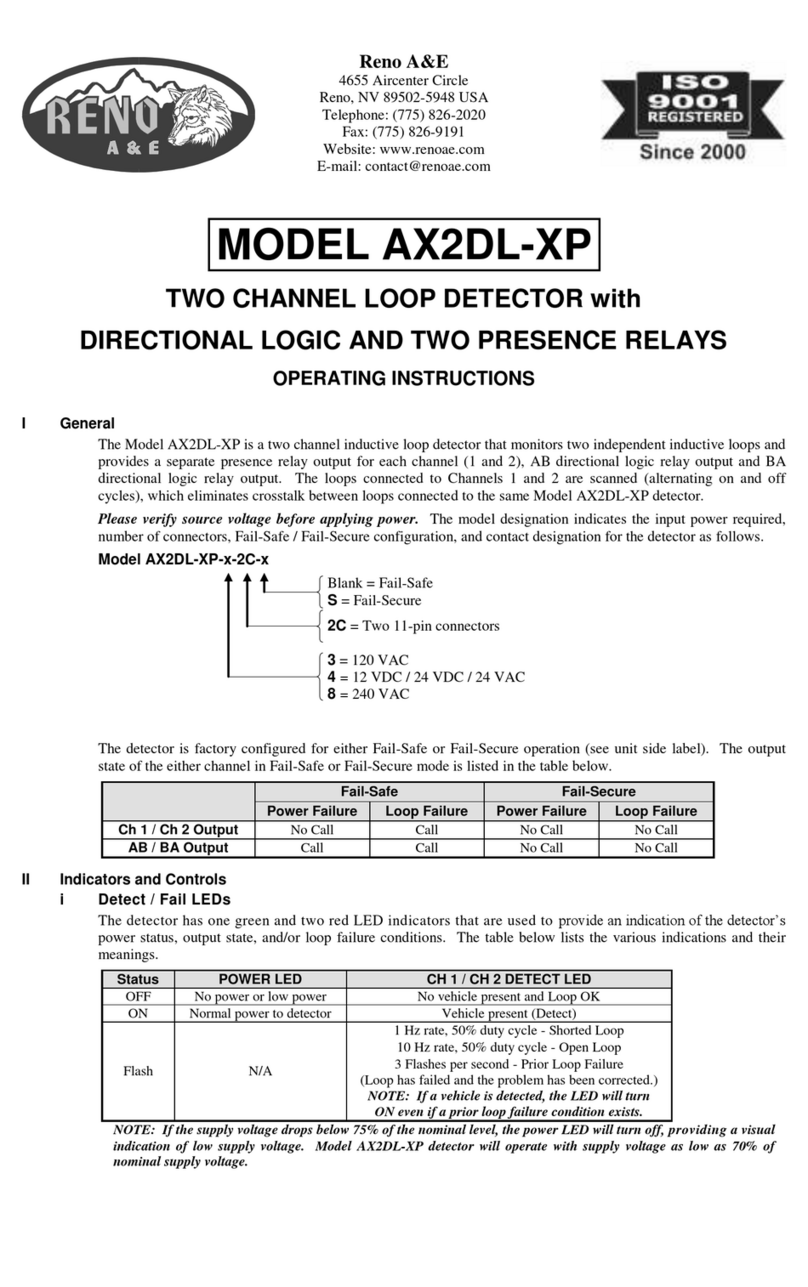
Reno
Reno AX2DL-XP operating instructions
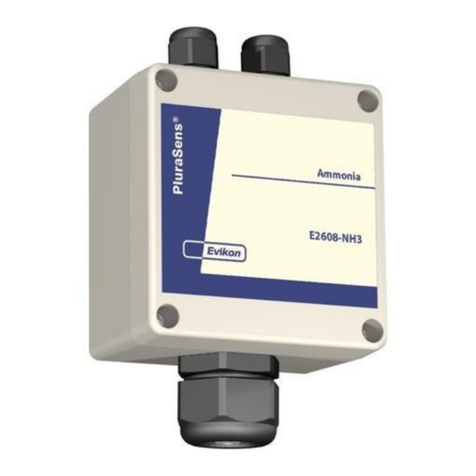
Evikon
Evikon PluraSens E2608-NH3-P user manual

Skyhawk
Skyhawk Kiwi IR Installation & user manual
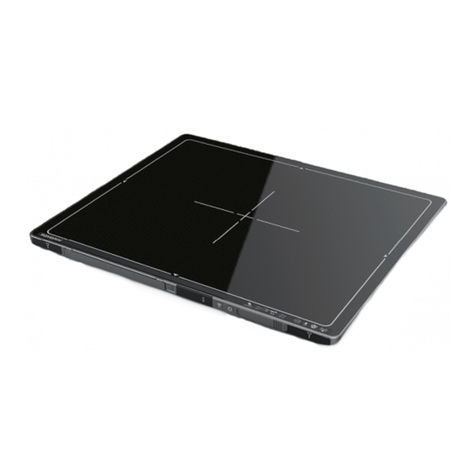
rayence
rayence 1417WGC User & installation manual
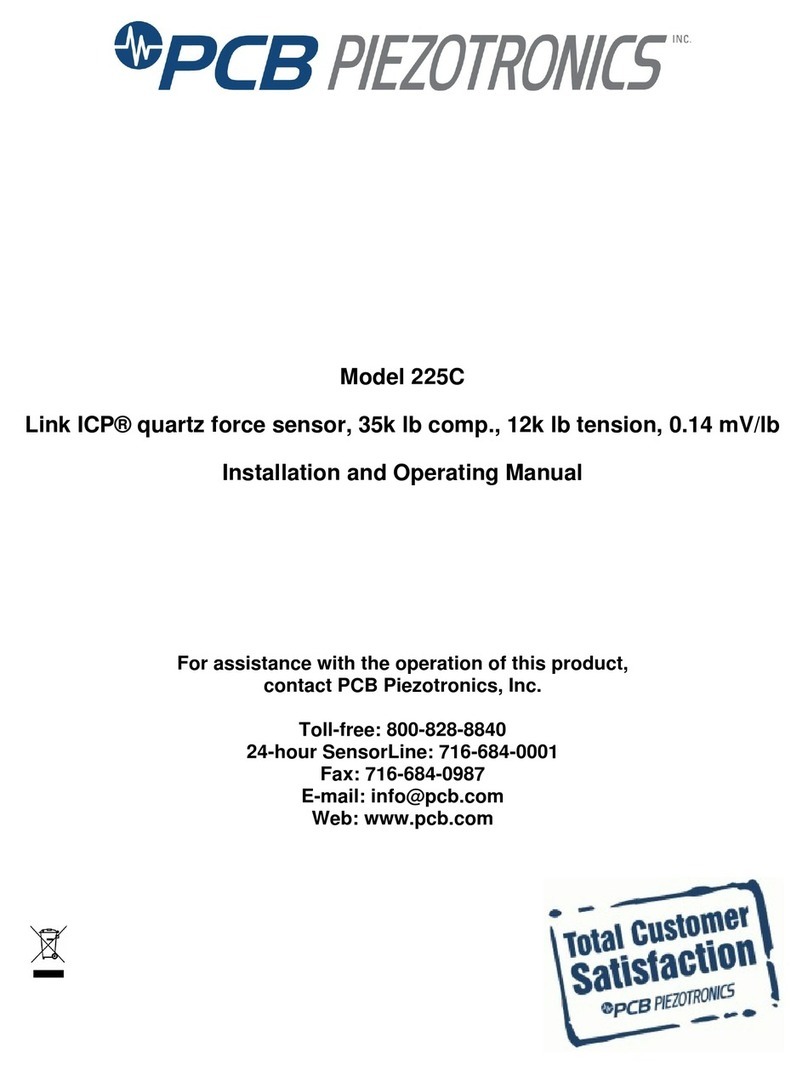
PCB Piezotronics
PCB Piezotronics 225C Installation and operating manual
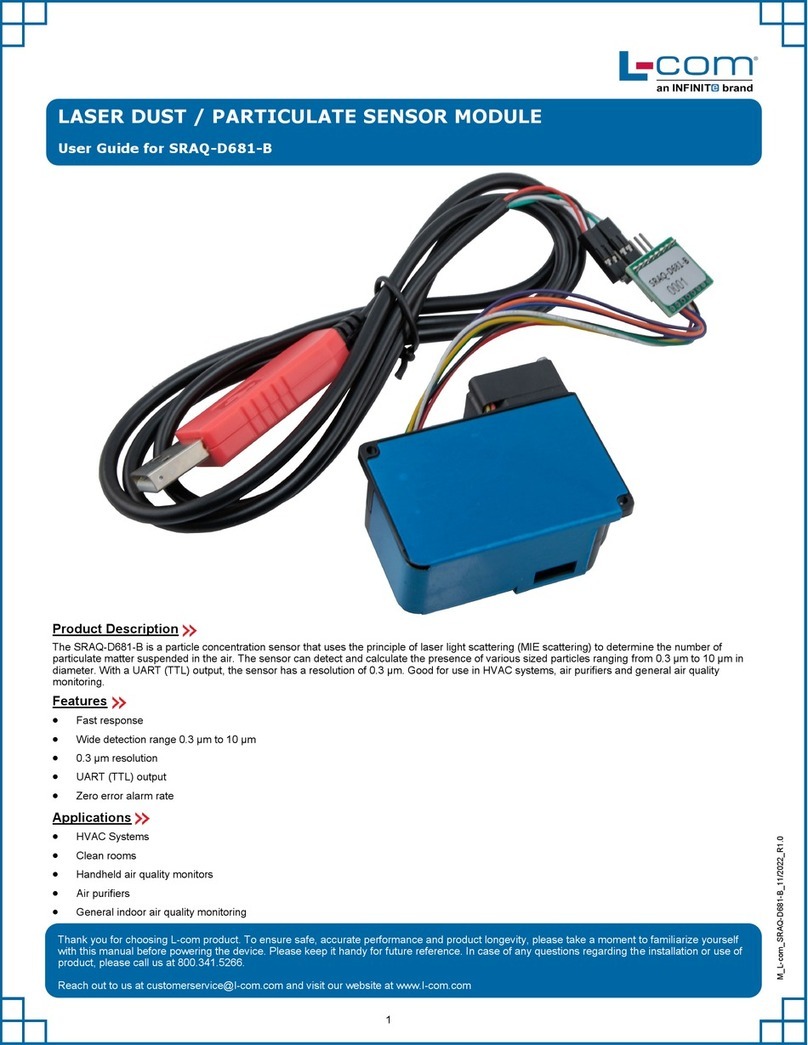
Infinite
Infinite L-com SRAQ-D681-B user guide
